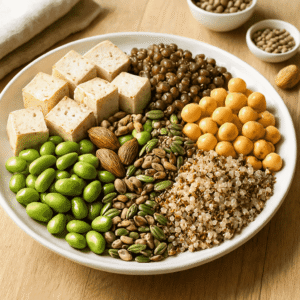Aging is a natural part of life; however, it has always been coupled with myths about fitness, especially. These myths create inhibition among aged people from engaging in any kind of physical activity, depriving them of the benefits of exercise and health. In this post, we break down common myths on aging and fitness for your peace of mind to continue with your activity and stay healthy at any age.
Importance of Fitness for a Lifetime

Fitness is important for all ages. For aging adults, maintaining fitness can strengthen muscles, enhance balance, increase flexibility, and improve mental health, allowing individuals to maintain independence and quality of life. However, myths surrounding aging are contributing to many unnecessary barriers, where people believe they cannot initiate or sustain their fitness journey. Let’s take a closer look at the facts and dispel these common myths related to aging and fitness.
Myth #1: “Older Adults Should Avoid Intense Exercise”

The Reality: Intense Fitness for Aging Adults
An intuitive feeling is that older persons should avoid high-intensity exercise. In reality, appropriately applied and if need be, closely monitored high-intensity exercise has become quite beneficial. Stimulatory physical activity such as interval training or resistance training, for example, tends to increase heart rate and enhance fitness, endurance, and cardiac health status among older persons.
Exercise Tips: Always listen to your body and consider modifications in order to make high-intensity workouts safe and enjoyable.
Myth #2: “You Can’t Build Muscle After a Certain Age”

Muscle Building and Fitness in Aging Populations
Another myth is that after a certain age, an individual cannot grow muscles anymore. Muscle growth decreases with age; however, strength training can still help create muscle mass gain along with improving metabolism and enhancing strength. Lifting or resistance bands work on building up and gaining muscle mass, among other benefits, significantly reducing the chances of a person suffering an injury.
Exercise Tip: Start with light weights and gradually increase as you build strength.
Myth #3: “Exercise is Dangerous for Older Adults”

Staying Safe and Fit: Myths and Misconceptions that Effects Aging
Proper exercise practices are not only safe but highly rewarding for older adults. Exercise strengthens bones, improves balance or prevents falls in the elderly. Counter such perception of exercise through improving stability and mobility-related physical activity, such as walking, balance exercises, and resistance training.
Exercise Tip: Consult a fitness professional if you’re unsure about starting a new routine, especially if you have specific health conditions.
Myth #4: “Older Adults Only Need Cardio”

Balanced Fitness for Aging Adults: Cardio and So Much More
Great cardio exercise can sometimes come in the form of walking, biking, or even swimming, but this kind of exercise is not the only thing an aging adult needs. Strength training, balance work, and flexibility exercises are big parts of a full fitness program for your child. The balanced approach to fitness makes sure that muscle mass does not decline, coordination improves, and bone density is supported.
Exercise Tip: Incorporate strength and flexibility exercises twice a week in addition to cardio.
Myth #5: “You Can’t Improve Flexibility or Balance Later in Life”

Flexibility and Balance: The Keys to Healthy Aging and Fitness
Many believe that with age, flexibility and balance are lost. Stretching, yoga, or even simple balance exercises can really improve these aspects. Being flexible and balanced reduces fall incidence, makes things easier to do daily, and definitely improves mobility.
Exercise Tip: Try yoga or tai chi to improve flexibility and balance while promoting relaxation.
Myth #6: “It’s Normal to Gain Weight as You Age”

Weight and Aging Fitness: Myth or Reality?
While the normal aging process does encompass weight gain, this tends to occur due to lifestyle changes associated with reduced activity levels and changed metabolism. Exercise can improve metabolic efficiency and manage weight for optimal weight throughout life.
Exercise Tip: Combine cardio with strength training to help manage weight and stay fit.
Myth #7: “Exercise Can’t Improve Mental Health in Older Adults”

The Mind-Body Connection: Mental Health, Aging, and Fitness
Exercise has always proved a number of benefits for mental health regardless of age. It can boost older adults’ moods, reduce stress, and improve their cognitive functions. Exercise boosts endorphins- natural mood lifters to help reduce symptoms of anxiety and depression.
Exercise Tip: Find activities you enjoy, whether it’s a daily walk, dancing, or a workout class, to stay consistent and boost mental well-being.
Myth #8: “Older Adults Need to Avoid High-Impact Movements”

High-Impact Exercises and Fitness in Aging: What’s Safe?
Even though some high-impact activities may need to be modified, older adults should not exclude them from their exercise repertoire. Proper technique and coaching help people of any age through the strengthening of joints, improving bone density, and increasing strength where those high-impact movements are occurring. The trick is moderation and knowing what feels comfortable.
Exercise Tip: Try low-impact alternatives, like brisk walking or water aerobics, if high-impact exercises feel challenging.
Myth #9: “A Slower Metabolism Means Fitness Goals Are Unreachable”

Tackling Metabolism Myths in Aging Fitness
The metabolism slows down with age, but this does not mean that a person cannot be fit. With the help of strength training, proper level of physical activity, and even proper diet, one is able to maintain a better metabolism that ensures staying fit and healthy despite the slowing of the general metabolic rate.
Exercise Tip: Aim for a combination of strength and cardio exercises to support metabolism and overall fitness.
Myth #10: “Older Adults Should Limit Protein and Calories”

Nutrition, Protein, and Fitness for Aging Adults
The elderly are sometimes asked to reduce protein and calories. However, proper amounts of protein are required for their muscles and energy. Sufficient protein in the diet helps maintain muscle strength and energy levels and improves their health, making them healthy and active.
Exercise Tip: Include high-protein foods like eggs, lean meats, or plant-based protein sources in your diet.
Practical Tips for Aging Fitness Success

- Set Realistic Goals: Start small and progress at your own pace.
- Listen to Your Body: Rest when you need it, and modify workouts based on how you’re feeling.
- Stay Consistent: more than occasional intense exercise; regular moderate exercise.
- Get Professional Guidance: If you are a beginner in working out, it would also be best to seek professional advice from a trainer.
Conclusion: Embracing Aging and Staying Fit for Life
Aging doesn’t mean giving up on fitness. By dispelling these myths and focusing on what’s truly possible, you can stay active, healthy, and independent at any age. Remember, fitness isn’t just for the young it’s for everyone, and it’s never too late to start.
FAQ’s
1. Can I start a fitness routine even if I haven’t been active for many years?
Yes, Never too late to start! Even begun in middle age, a fitness routine has its wealth of health benefits. The occurrence of aging does not mean there cannot be improvement in strength and flexibility. Start with low-impact exercises such as simple walking or stretching and increase the tempo according to adaptation with your body.
2. How often should aging adults exercise to maintain good health?
Adults who are aging should seek to do at least 150 minutes of moderate aerobic exercise each week, plus two days of strength training. Even light daily movement helps build fitness and is related to healthy aging for strength and balance.
3. Is strength training safe for aging adults?
Sure, Strength training is not only safe but also highly beneficial for older adults. It delays the loss of muscle mass with aging, improves bone density, and even enhances balance. Start with lighter weights and progress gradually, focusing on proper form to avoid injury.
4. Can older adults build muscle effectively as they age?
Absolutely! While the growth of muscle mass may slow down with increasing age, older adults can build and maintain muscle. In fact, it can counteract natural loss through consistent strength training and a healthy diet rich in protein.
5. Are there any exercises aging adults should avoid?
Some high-impact exercises, like intense jumping, may require modifications for aging adults to protect joint health. Consult a fitness professional to identify age-appropriate modifications for exercises that ensure safety and comfort.
6. How does exercise impact mental health for aging adults?
Commonly known to reduce stress, enhance mood, and improve cognitive function in the elderly, exercise also boosts one’s release of endorphins, which seem to act on their own to elevate mood as well as potentially work against or delay age-related cognitive decline.
7. Is weight gain inevitable with aging?
While metabolism does decrease with age, weight gain is not inevitable. Maintaining a healthy metabolism requires regular exercise, especially strength training. A healthy diet also goes a long way in managing weight during the aging process.
8. Do aging adults need more protein to support muscle health?
Older people need a bit more protein to build up and repair muscles. High-quality protein at the dietary level promotes muscle health, helpful in keeping ability and independence intact.
9. Should aging adults only focus on cardio workouts?
Cardiorespiratory exercise must be included, but this must go hand-in-hand with a balanced fitness program, which includes strength, flexibility, and exercises in balance. It helps with muscle preservation, coordination improvements, and joint flexibility; hence overall health is improved.
10. Can flexibility and balance improve even with age?
Actually, flexibility and balance do improve with age. For elderly persons, in particular, there are areas like yoga and tai chi, which help them stretch for the cause, support joint health, and lower the risk of falling.




